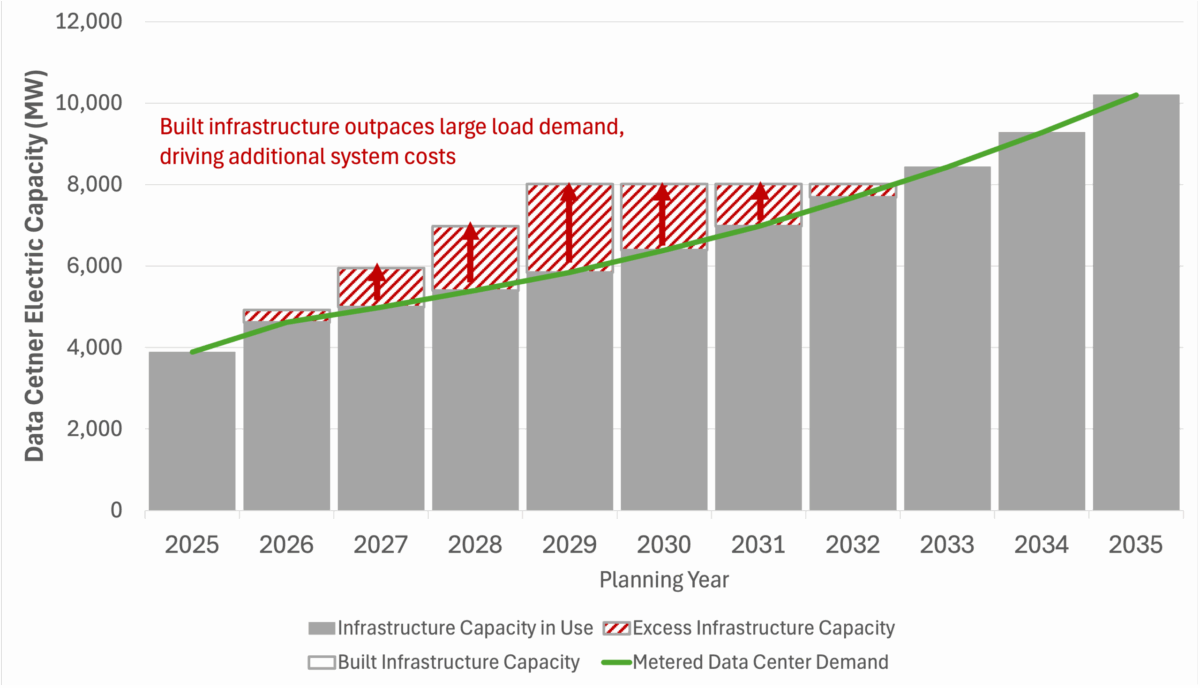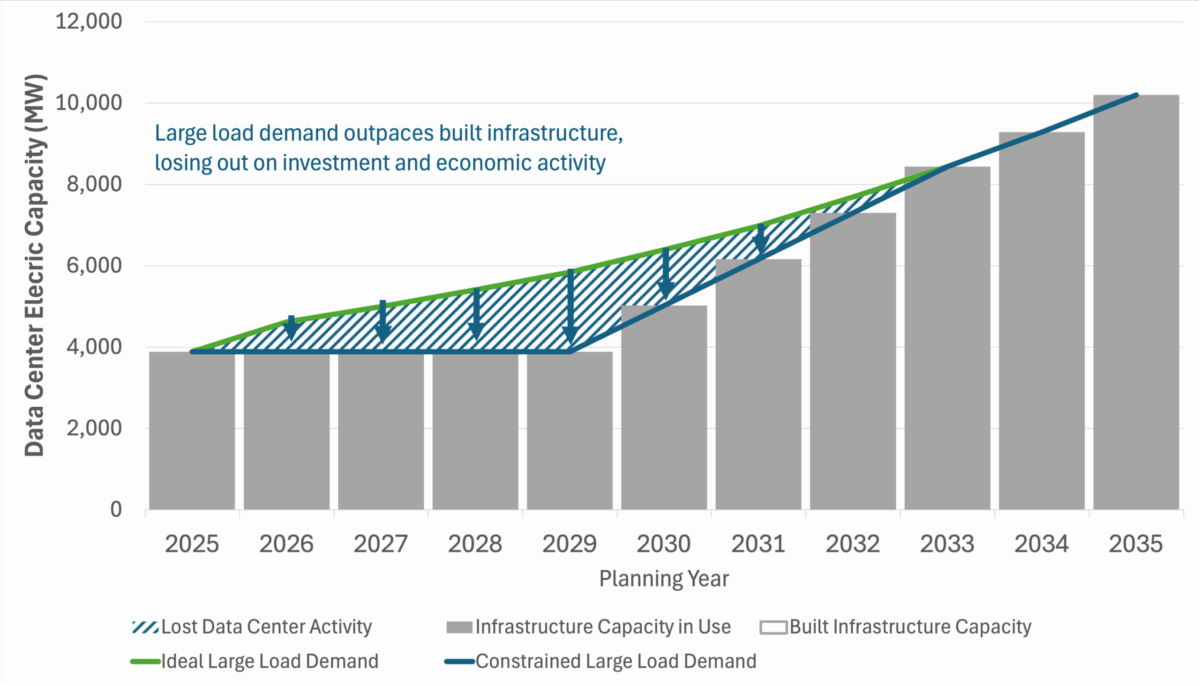Data center interior with glowing light trails. (3d render)

Rewiring Utility Planning for the Age of Rapid Load Growth
With growing demand, faster adaptive planning can prevent costly overbuilds, missed investments, and delays that slow the clean energy transition.
The rate of projected load growth in some utility territories is staggering. This demand for new power is leaving traditional utility planning processes ill-prepared to deliver resources to serve these customers while safeguarding rate payers from overbuilding. However, through innovations in procurement and planning processes, RMI offers ways to accelerate the process that supports both large load customers and everyday utility customers alike.
Traditional resource planning won’t cut it
RMI’s Engage and Act dataset shows that aggregate 2035 demand forecasts in utility plans (IRPs) have risen sharply — by over 20 percent — between December 2020 and June 2025. Some utilities today are receiving hundreds of megawatts of load requests quarterly. Georgia Power, home to one of the biggest data center booms in the country, has seen its anticipated demand in 2030 grow by 7 gigawatts, or almost half the current system’s peak demand, between its 2022 and 2025 IRPs. This demand for new power has triggered a cascade of revised utility forecasts, which are used as the foundation of utility investment decisions.
Yet, conventional utility integrated resource planning that rigorously assesses the right portfolios for investment is a slow process that could leave grid planners and regulators at a disadvantage in today’s environment. The average utility IRP is updated and re-released every 2.83 years, per Engage and Act data. That means that grid planners may not even identify potential resources to serve new loads until 3 years after a customer has made a request. Identifying a portfolio is traditionally followed by procurement that takes several months — and then there are 2 years of lead time to build even the fastest utility-scale resource options. If utilities and regulators stick to these business-as-usual processes, they’re unlikely to be able to deploy resources to meet new needs before the end of the decade.
Billions hang in the balance of proper grid planning
The stakes are high for getting the timing of investment “right” in planning and procurement processes. Underbuilding — building too little, too slowly — can mean missed economic opportunities. Overbuilding — building too much, too quickly — leads to unnecessary infrastructure, stranding costs and driving up electricity rates for everybody.
Consider a simplified example of a vertically integrated utility in Virginia. The utility’s forecast for metered large load demand as of December 2024, shown in green below, anticipates demand from data centers growing by about 600 megawatts per year, to 10.5 gigawatts in total, by 2035. The two charts below demonstrate the potential scale and impact of over- or under-building grid capacity:
Source: Metered Large Load Forecast from Dominion Energy Statement to Virginia State Corporation Commission; Cost of large load service derived from Testimony of Andrew J. Williamson to Indiana Utility Regulatory Commission, Cause No, 46097; Economic impacts of data centers in Virginia derived from Virginia Joint Legislative Audit and Review Commission 2024 Data Centers in Virginia Report.
In the “over-build” example, the utility builds more aggressively, perhaps in response to high volumes of new interconnection requests, larger forecasts, or a policy decision to try to attract more business to the state. This buildout outpaces demand through 2029, and then the utility pauses on construction until 2033. The costs of building infrastructure early fall on the utility’s ratepayers. Using costs approximated from a large load tariff proceeding in Indiana, we estimate the one-time costs of building capacity before it’s needed at almost $2 billion — about one-fifth of the utility’s total revenue from all customers in 2024.
In the “under-build” example, the entire region would lose out on almost $2 billion of direct Virginia GDP benefits associated with operating large loads — without even including the economic benefits gained by users across the world using the data center’s computing power. In our example, the utility does not construct additional capacity to meet large loads until 2029, perhaps due to the lack of a planning cycle before 2027 or supply delays for key infrastructure like transformers or gas turbines, after which it changes course and catches up with forecasted large load demand by 2033. This would lead to significant economic loss, based off of figures from this 2024 report to the Governor of Virginia.
While this is only an indicative example for a single utility, considering some estimates have US data center demand set to double, these billions are just a drop in the bucket of infrastructure building and data center economic activity. To avoid the costs of over- or under-building for the data center boom, we need to get planning right.
Meeting the need for speed: Ideas for utility planning processes
Across the country, utilities are starting to take important steps to modernize their planning and procurement processes to meet the speed of business while maintaining the rigor needed to reduce risks related to misaligned forecasting. Even with points of progress, there are opportunities to adapt grid planning to meet the moment — and a need for even more innovation.
Faster, more sophisticated forecasting and planning
Today, there are opportunities to reduce the information lag associated with current planning practices. Looking out further, there are opportunities to speed up the exercise of planning itself. Planning today is an extremely time-intensive exercise — and frequent updates and revisions can strain utilities, regulators, and intervenors. Yet, new modeling approaches and access to new tools for automation may have the potential to simplify modeling and reduce the burden of oversight.
What we’re seeing: Utilities are already releasing updates on critical assumptions, such as load forecasts, between planning cycles. With transparent updates from utilities, regulators and stakeholders can better track progress, anticipate changes in upcoming plans, and identify needs for interim planning or procurement. As we detail in our recent report Get a Load of This, Georgia Power and Duke Energy have been required to file more frequent updates on their large load requests that comprise forecasts — the former on a quarterly basis.
What’s left on the table: Faster, more adaptive planning techniques can help utilities keep pace with how quickly conditions — such as load forecasts — now change. More flexible approaches — such as testing a range of possible futures to identify investment options that perform well across all of them (sometimes called a stochastic approach) — can help utilities make sound decisions even when reality doesn’t match the original plan.
This type of approach can be supported by new modeling techniques that simplify the process. Traditionally, planners have relied on a multi-step process, using capacity expansion models to design an optimal portfolio, and then iteratively testing those results by conducting economic and reliability analyses. Now, organizations like Telos Energy are exploring alternative techniques that remove capacity expansion modeling altogether. This reduces the computational burden, allows more options to be tested, and makes it possible to update plans more often.
More frequent procurement processes that still complement longer-run planning
Current procurement processes (actions utilities take to build the resources indicated in their plans) often flow directly from decisions made in the IRP. There are opportunities to take planning and procurement out of sequence or run multiple procurements between plans, while still using the IRP as a strong foundation for those decisions.
What we’re seeing: Utilities are more frequently conducting IRP updates to justify incremental procurement between long-term plans, making updates to key assumptions. For example, Georgia Power issued a 2023 IRP update that projected 6,600 MW of demand growth through 2031 — up from 400 MW just a year earlier. The update resulted in a settlement that will increase planned investments in solar, gas, storage, and distributed energy resource programs. On the other side of the country, NV Energy amended its 2021 IRP five times in three years. These amendments enabled quick procurement of new generation resources but occurred with limited regulatory oversight compared to the typical IRP process.
What’s left on the table: IRPs can also be designed to analyze options for procurement by customers through tariffs. Outside of the standard planning and procurement process, utilities are turning to large load tariffs to set the conditions under which new loads can take service. Some large load tariffs also contain provisions that allow large loads to bring their own generation or work with the utility to secure generation on their behalf (e.g., Nevada’s Clean Transition Tariff), and interconnect more rapidly than if they were served by traditional procurement.
However, there is an opportunity for tariffs to better complement the IRP process. Ideally, an IRP would be able to identify two possible inputs for tariff-based procurement: (1) a baseline “marginal” resource technology that could be procured if a new load materialized and (2) other resource technology options that may not be prioritized by status-quo planning, but could provide system-wide benefits under a range of conditions. Equipped with these options from resource plans, tariffed customers could make informed, cost-effective choices to build incremental resources that meet their needs.
Similarly, IRPs could be used to develop market signals that lead to smarter, more affordable grid investments. For example, identifying “Large Load Zones,” in planning could direct investments into areas that are more cost-effective to serve today or create greater planning certainty about where to build new resources.
The need for bold innovation
Reimagining utility planning and procurement processes to best meet this period of sustained load growth will require bold innovation. While there is a need for more experimentation, the stakes are clear: if we cannot adapt rigid utility processes to the rapidly evolving needs of the grid, we risk making improper investments in our grid, leaving significant economic opportunity on the table. To learn more about RMI’s research covering grid planning, or to contribute to developing utility planning processes that meet the need for speed, contact Charles Cannon <ccannon@rmi.org> or talk to an RMIer at the upcoming National Association of Regulatory Commissioners Conference in Seattle.


